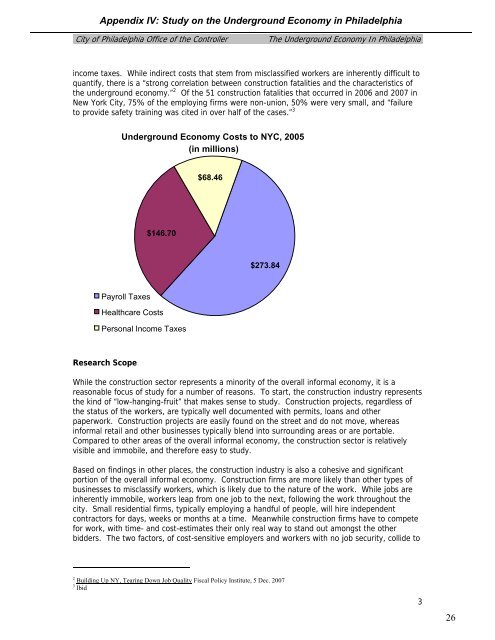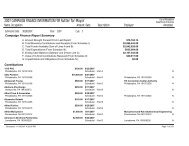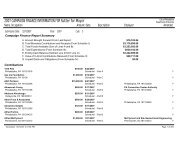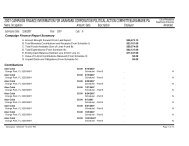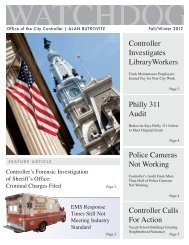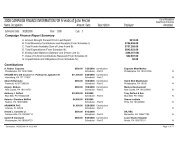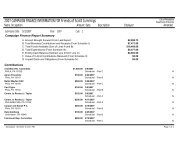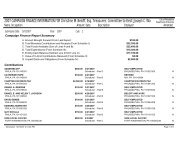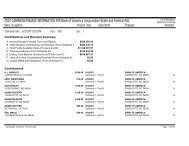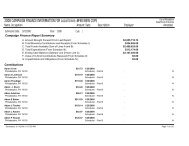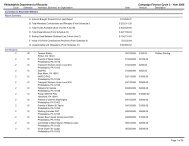department of revenue tax discovery program action steps to
department of revenue tax discovery program action steps to
department of revenue tax discovery program action steps to
You also want an ePaper? Increase the reach of your titles
YUMPU automatically turns print PDFs into web optimized ePapers that Google loves.
Appendix IV: Study on the Underground Economy in Philadelphia<br />
City <strong>of</strong> Philadelphia Office <strong>of</strong> the Controller<br />
The Underground Economy In Philadelphia<br />
income <strong>tax</strong>es. While indirect costs that stem from misclassified workers are inherently difficult <strong>to</strong><br />
quantify, there is a “strong correlation between construction fatalities and the characteristics <strong>of</strong><br />
the underground economy.” 2 Of the 51 construction fatalities that occurred in 2006 and 2007 in<br />
New York City, 75% <strong>of</strong> the employing firms were non-union, 50% were very small, and “failure<br />
<strong>to</strong> provide safety training was cited in over half <strong>of</strong> the cases.” 3<br />
Underground Economy Costs <strong>to</strong> NYC, 2005<br />
(in millions)<br />
$68.46<br />
$146.70<br />
$273.84<br />
Payroll Taxes<br />
Healthcare Costs<br />
Personal Income Taxes<br />
Research Scope<br />
While the construction sec<strong>to</strong>r represents a minority <strong>of</strong> the overall informal economy, it is a<br />
reasonable focus <strong>of</strong> study for a number <strong>of</strong> reasons. To start, the construction industry represents<br />
the kind <strong>of</strong> “low-hanging-fruit” that makes sense <strong>to</strong> study. Construction projects, regardless <strong>of</strong><br />
the status <strong>of</strong> the workers, are typically well documented with permits, loans and other<br />
paperwork. Construction projects are easily found on the street and do not move, whereas<br />
informal retail and other businesses typically blend in<strong>to</strong> surrounding areas or are portable.<br />
Compared <strong>to</strong> other areas <strong>of</strong> the overall informal economy, the construction sec<strong>to</strong>r is relatively<br />
visible and immobile, and therefore easy <strong>to</strong> study.<br />
Based on findings in other places, the construction industry is also a cohesive and significant<br />
portion <strong>of</strong> the overall informal economy. Construction firms are more likely than other types <strong>of</strong><br />
businesses <strong>to</strong> misclassify workers, which is likely due <strong>to</strong> the nature <strong>of</strong> the work. While jobs are<br />
inherently immobile, workers leap from one job <strong>to</strong> the next, following the work throughout the<br />
city. Small residential firms, typically employing a handful <strong>of</strong> people, will hire independent<br />
contrac<strong>to</strong>rs for days, weeks or months at a time. Meanwhile construction firms have <strong>to</strong> compete<br />
for work, with time- and cost-estimates their only real way <strong>to</strong> stand out amongst the other<br />
bidders. The two fac<strong>to</strong>rs, <strong>of</strong> cost-sensitive employers and workers with no job security, collide <strong>to</strong><br />
2 Building Up NY, Tearing Down Job Quality Fiscal Policy Institute, 5 Dec. 2007<br />
3 Ibid<br />
3<br />
26


